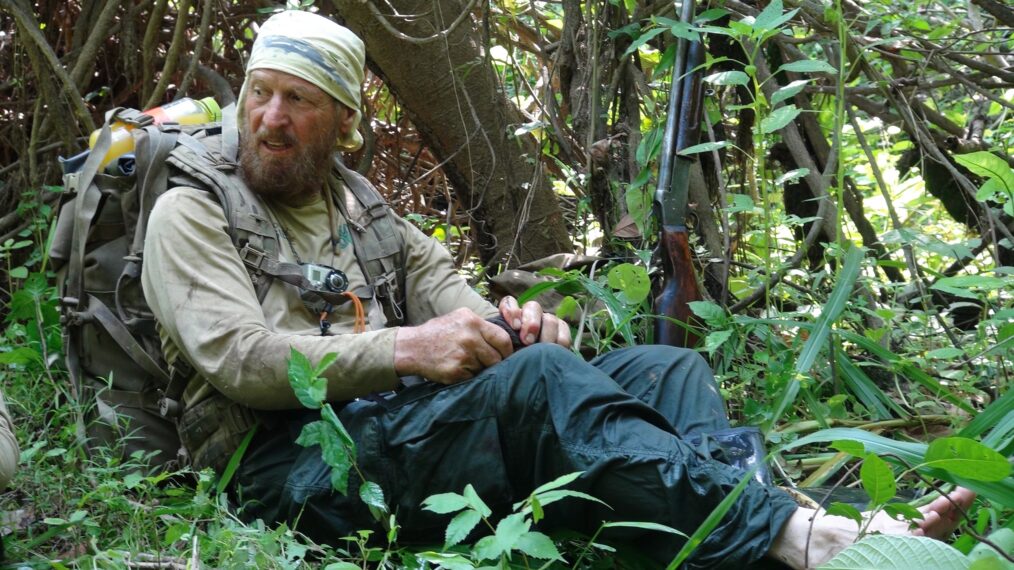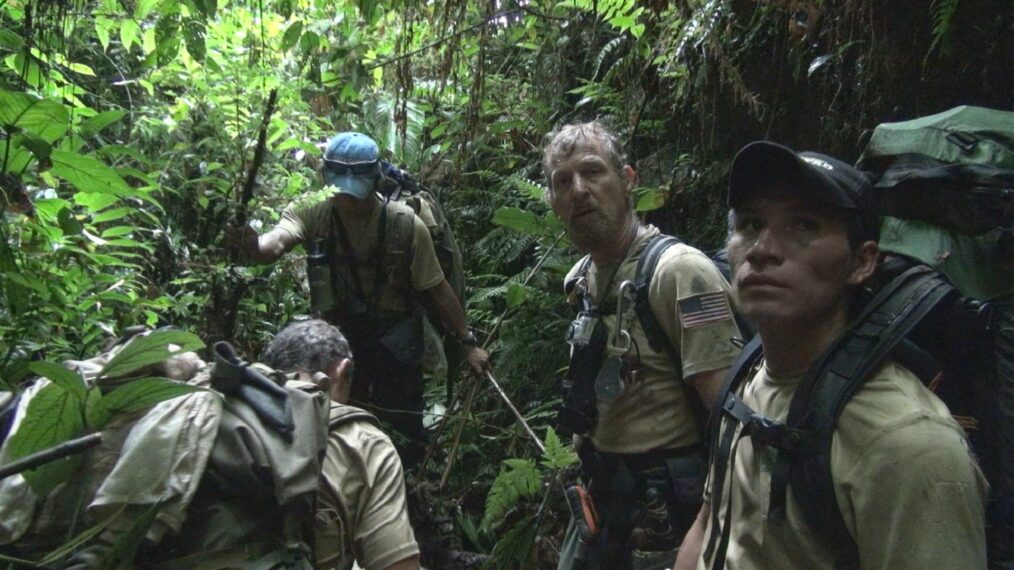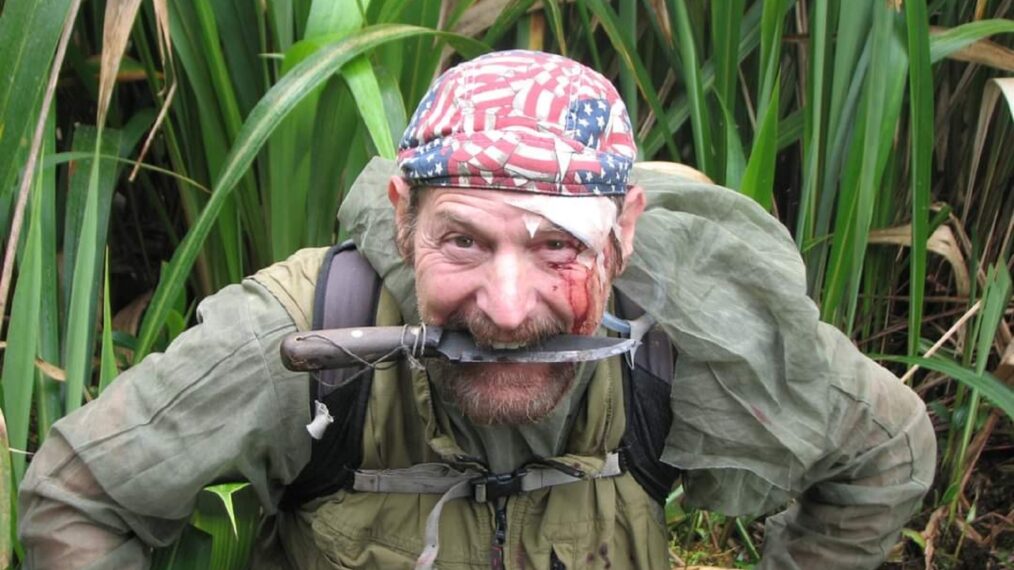A doomed expedition through the Amazon is at the center of Expedition From Hell: The Lost Tapes. The docuseries follows an eccentric guide Mickey Grosman, a former special forces demolition expert, who brought on a group of novice survivalists to follow him on his 5,000-mile journey across the jungle and South America. Those who signed up to take this trip found out quickly they’d gotten far more than they bargained for.
This may read like a premise for a big-budget summer blockbuster and hard to believe at times if there weren’t over 700 hours of archival footage from the trip that documented all the misfortunes including a kidnapping, prison escapes, and a missing person. Those who lived through this experience back in 2012 reflect on their time in the Amazon and all they’d endured with Mickey at the helm.
Ahead of the two-hour premiere, Showrunner/EP Erin Gamble and EP/Director David Freid preview the insanity to come.
How was the footage acquired and at what point did you realize you had a docuseries on your hands?
Erin Gambe: Sometime after he had finished the expedition, Mickey brought all the hundreds of hours of footage he’d shot to a producer, and they created a documentary that very much represented the heroic way Mickey saw himself and the expedition. Our producing partners, Wrigley Media, saw it and wondered if there was more to the story. They brought it to us at IPC to see what we thought.
It quickly became obvious that there was a lot more going on than the fairly straightforward narrative Mickey had first suggested. But at the time the raw footage was incredibly disorganized. It was a whole hard drive cluttered with four and six-minute bits of sometimes explosive video. We saw people with guns, there was what looked like a raid by military police, people falling off things, people having screaming fights, but there were no logs or lists at all. We couldn’t even tell what dates things had happened, or what two pieces of video went together. So there was clearly something here, but the picture of what it was was still very unclear.
David Freid: In the earliest days, we were trying to get a grip on the enormous amount of footage they shot, and we did a few pre-interviews with some of the subjects. There were a lot of good stories, the details of which often didn’t line up between subjects and it was pretty clear early on that this wouldn’t be a normal expedition/survival show. Whenever we tried to answer a question, we’d find three more questions we didn’t know to ask. This is when you know it’s interesting. The deeper we went, the more fun it got.

Discovery Channel
Do you think Mickey’s motivation was to produce something such as this to sell to networks?
Erin: Mickey invested an enormous amount of time, money, and effort in making sure that a camera was running almost every moment of this incredible trek. He taught everyone on the expedition to run a camera, and he got really upset whenever anything was missed at all. So I don’t think he ever made a secret of his intent to make this into some sort of documentary. I think what people are really wondering when they ask this question is how much Mickey wanted to promote himself, not just the expedition. That’s a harder question to answer. Maybe the best way is to say that Mickey is someone for whom many things can be true at once.
David: Filming this thing was definitely a priority. Maybe at times the biggest priority for Mickey. Which is not great for a group of people trying to survive the Amazon. He took three cameras (not to mention batteries, hard drives, and solar-powered charging equipment) into the jungle, so he definitely wanted this expedition to be well-documented. He often told people along the way that the whole world was watching — sometimes as leverage to open doors, or in an attempt to get himself out of trouble. Maybe he just thought this would end up on Amazon’s 5,000 social channels and not a limited series on Discovery and Max. But who knows? Maybe this was his goal all along and I too am part of Mickey’s plan.
How much do you think of what we see from Mickey do you see was an act for the cameras?
Erin: I’d say Mickey is very true to himself. He’s pretty consistent – what you see, is pretty much what you get with Mickey.
David: Everybody changes a little bit when the cameras are on. Did he put people in danger to get a good shot? You’ll have to watch it. But if you’re wondering if Mickey is calm and professorial off camera — no.
What was the process like of deciding what footage you wanted to use?
Erin: When we first realized the state the raw footage was in, it was almost a bit disheartening. It felt a little overwhelming, not only that you didn’t really know what had happened, but that you didn’t know when anything had happened, whether it was before or after, or what two pieces of media went together. You’d find a bit of video with two people screaming at each other and have no idea what was going on. I was constantly asking, “But was that the first moment the camera turned on? When did this argument start? Where’s the end of it?’”
So it was a really long process of sorting and organizing, and figuring out how to do a sort of forensic investigation into the footage. I’d say the most helpful things wound up being the metadata, and the information from the original Amazon 5000 Facebook posts. Those were all helpful markers for us to cross-reference. That sort of provided the initial idea of what the big events were. But then there was actually watching all the footage.

Discovery Channel
David: In the early days, we were constantly discovering. If you film all day every day, you’re going to end up with a lot of stuff you don’t need. We’ve got lots of footage of walking, nondescript jungle foliage, a shaky pan toward indistinct movement in the trees that were probably birds — and more than one very uncensored shot of someone relieving themself. So we decided not to use all of that. It was a long process of sorting and organizing, and a sort of a forensic investigation of the footage.
Erin: As much as possible, I really wanted to get eyes on every bit of footage, and make a decision for ourselves about what was interesting or important, not just presume that what we’d been told was the whole story. The post team and I put up these enormous boards and every time we found something in the footage that we thought might be interesting, we’d put a different colored index card up on the board. The boards started to look like something out of A Beautiful Mind.
David: …Or that Pepe Silvia, It’s Always Sunny conspiracy meme.
Erin: But what really got intriguing was that over and over we’d have heard that something happened – like, for instance, the kidnapping by the indigenous tribe – and then we’d get into the actual footage, and all of a sudden we’d have a million questions about what we were watching and whether it supported the narrative we’d been told or not. By the time we were ready to conduct the interviews, I had realized the story of figuring all this out was somehow going to be part of the show too, although I still wasn’t clear exactly how important that was going to become.
David: There’s definitely a breaking-the-fourth-wall element here, as we wanted the audience to go down the same rabbit hole we were lost in. To show them how wild the untangling of this story had gotten. And in regards to deciding what footage to use — the last thing I’ll say is — sometimes the footage you don’t see is even more important.
How would you describe what viewers will see over the course of the season?
Erin: From the very beginning we’ve always talked about this as being more than just the story of an expedition. But there were definitely things we figured out that really surprised me as we went along. Eventually, it became important to come up with a way to work our own questions and process of trying to get answers into the structure of the show and give the audience some of the same experience we had in asking these questions. I think you really start to see that in Episodes 4 and 5 especially.
David: The deeper we get into the story, the more we see that the footage isn’t the entire story. And the more you see us putting together the pieces, which eventually becomes part of the story. I hope the audience feels like they’re on the same journey of discovery that we were on, as we were constantly surprised at what we found.
Was it difficult getting those on the expedition whether they be those Mickey hired or expedition members to participate in the project and reflect on their experiences?
David: Definitely. Not everyone left this experience feeling great about it, as you’ll see. Some people seemed afraid of getting on the wrong side of Mickey. Those ones just ignored us at first. Once I was able to reassure them that we weren’t working for Mickey and that this wasn’t just a continuation of Mickey’s own project, they were much more receptive. And when we finally sat down with them, they seemed to be relieved to finally tell their stories.
One of our subjects said that this was the first time he’d told anyone about what he went through, and you could tell that was a big weight coming off of him. One member of the expedition opted not to do an interview with us because they said they didn’t want to revisit the experience. And another person — well, you’ll see.
Erin: What got most interesting for us was trying to figure out who was talking to whom. We started to get the impression there was a lot of communication between people trying to decide whether to participate, including Mickey having conversations we didn’t know about. And once people agreed to talk to us we’d sometimes show up to an interview to have someone say, “I heard you were asking so-and-so about this, what did you find in the footage?”
Because we were using these interviews to help us understand and piece together what we were watching in the footage, we started to carefully keep track of who we were talking to about what. By the end of it, everyone seemed really invested in sharing what they knew to figure out what had actually gone on. And I think many of the contributors found they wound up with a new perspective on what they’d gone through years before.
What do you think will be the most eye-opening parts of this docuseries?
Erin: The last episode. The questions we ask there are ones I had no idea we would be asking when we started this series. I still remember standing in the grocery store in the cheese aisle getting a call saying, “I think we found it, we’ve got the smoking gun.”
David: The best answer is the one we really can’t give just yet because it’s the last episode. We want the audience to go down the rabbit hole, and experience it the way we did. But there’s this one guy who really helped to demonstrate how difficult this expedition was. In order to get to the middle-of-nowhere jungle, each person had to go through a lot of logistics — from the initial application and approval process to making plans to separate from life, work, and family — mental and physical preparation, packing gear, taking a couple of long flights into foreign places — and this one guy joins the team, starts climbing into a cloud forest, and turns around and goes home only two hours into the expedition. After all of that preparation, his expedition ended after two hours.
Were you surprised by how many people not only joined him but stayed with him on this journey after seeing what they were getting into? Or do you think they felt trapped?
Erin: I think that was one of the most stunning things for me about watching the footage in the early days. We asked that question of people a lot. At first, I simply couldn’t understand why people just didn’t walk away. By the end of the whole experience, I think I understand it better. Every person we talked to described this as one of the most significant experiences of their lives. Everybody had a different reason, but it absolutely changed everyone who participated.
David: Yeah, this was something we talked about a lot in the early days. You’ll see how hard this trip was on people, mentally and physically. Yet several of them stuck it out. At first, it felt almost cultish — where Mickey put his team into situations that only he could save them from. Some participants would give him the benefit of the doubt no matter what hell they were going through, even saying things like “it must be part of Mickey’s plan”. Like the struggle is the point. Some kind of test.
There’s a lot that happens that seems poorly prepared and dangerous, and maybe just flat out a big mistake. But the further we got into reconnecting with the expedition participants, the more I realized that sometimes a confident answer is more important than the right answer. A lot of these guys wanted strong leadership, and Mickey gave it to them.
Was I surprised by how many people joined? No. It sounded like an adventure. Something bigger and more exciting than what normal life is for many. Honestly, I was probably Mickey’s target audience, and if he found me 12 years ago, I might’ve joined him. I’m more surprised by how many people want to get naked and afraid.
What does Mickey think of this project if he is aware? Did he decline to participate?
Erin: The show couldn’t have been made without the Amazon 5000 footage, so Mickey was always aware there was a show being made. But there was certainly a point where he realized it was not going to be a remake of his documentary, and things got pretty interesting then.
David: Part of what’s fascinating about this whole project is how much Mickey controls the experience. You’ll see it in the footage — there isn’t a detail he doesn’t manage. During development, I’d joke about putting on my tinfoil hat before saying something like, “Mickey’s still controlling the narrative!”
What can you tease about what we’ll see for the rest of the season?
David: Some combination of Apocalypse Now and Tropic Thunder starring Don Quixote. Mickey’s single-minded determination to finish had us wondering what the impact was on him. It felt like, the deeper we got, the more we witnessed someone’s relationship with reality changing. How far will Mickey go to accomplish his 5,000-mile goal?
What do you want people to walk away with after watching?
Erin: Whenever I make something, I’m always thinking: this viewer just gave me an hour of their life, what did I give them in return? This is an experience that 99.9 percent of us will never have, and yet the people who went through it felt like it was one of the most significant things in their lives. I hope by the end of it, people will actually feel a bit of why. And I hope they get to have the same sort of experience we had trying to piece the story together: listening to all the various perspectives – the things this person remembered, and the realizations this person shared – and then weaving it all together into a really interesting and surprising whole.
David: Why do we do hard things? Why do we put ourselves through hell for an experience? Two big themes I was wrestling with since the earliest days of this project were purpose and legacy. The idea that doing something bigger than ourselves gives our lives meaning, and with someone like Mickey, who’s now in his 70s — what is he leaving behind? That’s part of why I think we were able to acquire all of these tapes all these years after the expedition. Mickey’s ready for his story to be told. I hope the audience gets a sense that they’re not alone in looking for a big adventure and a sense of purpose. Or, if not that, I hope they learn that you need to have good shoes in the jungle.
Expedition From Hell: The Lost Tapes, Premiere, May 12, 10/9c, Discovery Channel and Max
Read the original article here



